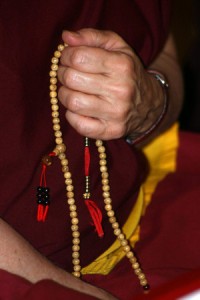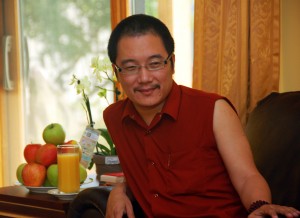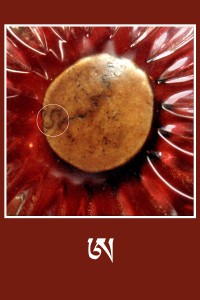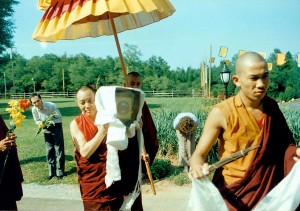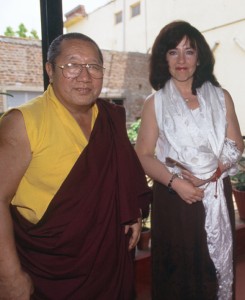The following is an excerpt from a teaching by Jetsunma Ahkon Lhamo called “Neurotic Interaction to Guru Yoga”
If we rely purely on an emotional level, not much will come of the path. If we do not challenge ourselves to truly understand all of the thoughts that turn the mind (and you’ve been taught them many, many times. You can go back and re-listen to the teachings if you aren’t sure what they are), if we do not require of ourselves to really recognize this precious opportunity, we won’t get very far. And now the recognition has to go even deeper than that. Number one, understanding that the teacher is a spiritual ally, a spiritual friend—someone on whom you can depend as a spiritual guide or a spiritual friend—is a really important first realization. Secondarily, you must understand that this reality that you are looking at when you see your teacher, when you see the Buddha, the Dharma and the Sangha, is to be considered separate from ordinary samsaric cause and effect conditions, or separate from the wheel of death and rebirth, because this is all the result of the Buddha’s teaching which arises from the mind of enlightenment and, like a seed, it must always create a fruit that is appropriate to that seed. So if this reality rises from the mind of enlightenment, it results in enlightenment as well. The seed and the fruit are always consistent.
That being the case, this is understood as something different. Now, if you wish you can, like that Tibetan man with His Holiness Penor Rinpoche regarding his opinion on my enthronement (this student did not agree with His Holiness Penor Rinpoche’s recognition of Jetsunma) waste the opportunity by just playing out your little intellectual ‘here’s my idea, what’s your idea. I’ll see you as something equal to my common ordinary intellectual mind in the world. You know, I’ll see you as that.’ Or you can play the game where “O.K., you’re the Guru, so I’m going to call you the real thing, but in my heart, in my mind, I’m pretty much just going to keep doing exactly what I’m doing, but I’ll have a teacher,” rather than gathering oneself together in order to understand something about this primordial wisdom nature, rather than trying to move further on the path of accomplishing pure view, rather than utilizing the teacher as a way to untangle some of our neuroses and actually seeing the condition of our mind and how different that is from what the Buddha described when the Buddha said simply, “I am awake.” The Buddha didn’t say, “I’m different from you.” The Buddha didn’t say “I am better than you.” The Buddha said “I am awake.” Awake to that nature that is also your nature.
Now supposing that you could use the relationship with the teacher to puzzle that out, to work that out. It’s such a fine line how to you give rise to or at least, shall I say not suppress, not give rise to, conflicting thoughts that you may have. How can you not suppress them and still utilize the teacher faithfully in the best possible way? Not as something common and ordinary that is equal to your own conceptual proliferation because then you could do that with anything. We do that with all of our relationships. We do that with all of the areas in life that we work with. We have preconceived ideas that we play out in our lives. Why would the teacher be different then? Why would it be precious? What’s the value then of having a teacher?
So it becomes the student’s responsibility to harness their mind. It isn’t about going brain dead. It isn’t about suppressing your ideas and your thoughts and your feelings. It’s about recognition between what is ordinary, habitual, definitely part of birth and death cyclic existence, that which arises from ordinary cyclic existence, and always therefore results in more ordinary cyclic existence, or that which arises from the precious primordial awakened state that is also your nature, and therefore always results in that precious primordial state that is also your nature—enlightenment. You are the one that must make the distinction.
So the Buddha recommends this: Take a long time determining your relationship with your teacher. If at first you have an emotional reaction, that’s fine. You don’t just suppress that either, but don’t stop there. It’s a big mistake just to stop there, because otherwise you just stay in some kind of wacko bliss thing. You could get that wacko over a cute little puppy or something, or a new car, or a new honey. You gets lots more wacko about a new honey, don’t you? Way more wacko about that! So your responsibility then becomes the responsibility of recognition. You have determined that this teacher has the necessary qualities to give you what you need. You can travel on the path now. You can understand very clearly. The teacher has a way of explaining to you and you can understand. You can hear it. You mind is opening. It is ripening. It’s deepening. Your compassion is increasing. Something is happening here and you are able to determine that this is not ordinary because this didn’t come from ordinary experience.
You’re travelling the path of Dharma and this is precious. This teacher has hooked you onto the path of Dharma, placed your feet there, deepened and ripened your mind, provided for you all of the necessary accoutrements. Therefore this is precious. You then must determine that this is different for you. You see, it’s not up to the teacher to provide proof for you. It’s not up to the teacher to convince you. It’s up to you to determine for yourself. Take your time, do it right, move through all the foundational teachings and decide for yourself: Is this precious to me? Then if it is, treat it like it is.
Copyright © Jetsunma Ahkon Norbu Lhamo. All rights reserved


